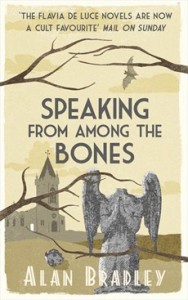March Crime
Alex by Pierre Lemaitre published by MacLehose Press
The Swedish Girl by Alex Gray published by Sphere
Speaking from Among the Bones by Alan Bradley published by Orion
Reviewed by N. J. Cooper
Victorien Sardou, author of Tosca among many other plays, advised young hopefuls to ‘torture the women’ if they wanted to succeed as dramatists. Many modern crime writers have taken his idea to extremes – and great commercial benefit. One publisher told a novelist that they’d put a dead woman on the cover of her book even though her victim was male because ‘dead men don’t sell books; dead woman do.’
 Pierre Lemaitre has several dead men in his novel Alex, but he also has a woman kidnapped, tormented and suspended in a cage too small for her body in an abandoned, rat-filled warehouse. When her abduction is reported to the police, the case is handed to Commandant Camille Verhoeven. He is an excellent character, with the traditional trauma in his past. In his case, his defining experience was the kidnap and death of his pregnant wife. He is also only four foot eleven, victim of his mother’s smoking in pregnancy, which left him with foetal hypertrophy.
Pierre Lemaitre has several dead men in his novel Alex, but he also has a woman kidnapped, tormented and suspended in a cage too small for her body in an abandoned, rat-filled warehouse. When her abduction is reported to the police, the case is handed to Commandant Camille Verhoeven. He is an excellent character, with the traditional trauma in his past. In his case, his defining experience was the kidnap and death of his pregnant wife. He is also only four foot eleven, victim of his mother’s smoking in pregnancy, which left him with foetal hypertrophy.
Parts of this novel are so horrible I could hardly bear to read them, but I could not abandon it. Classically constructed as a three-act drama, it leads you on through loathing, fear, excitement and, ultimately, horrified sympathy. Frank Wynne’s translation is good, too, rarely breaking the grip of the text with an ill-chosen word or phrase.
 The only torture in Alex Gray’s new novel, The Swedish Girl, is the emotional kind, although there are plenty of women victims. The ‘girl’ of the title arrives in Glasgow to study at the university and live in a flat bought by her billionaire father. He is such a control freak that he handpicks the three students who become her tenants. One is Kirsty Wilson, daughter of a police officer, who is a great cook and plump and plain enough to be no rival to the ravishing Eva Magnusson. When Eva is found dead and one of the other flatmates is arrested and locked up on remand in Barlinnie, Kirsty decides to fight for him. With all her family connections to the police, she is well placed to ask for help, and offer her own informal services. The tone of the novel is warm and intriguing. Apart from one crashing coincidence and some unlikely latitude offered by a Detective Chief Superintendent, the story is well told, and the final revelation comes with all the sad inevitability of the best of the genre.
The only torture in Alex Gray’s new novel, The Swedish Girl, is the emotional kind, although there are plenty of women victims. The ‘girl’ of the title arrives in Glasgow to study at the university and live in a flat bought by her billionaire father. He is such a control freak that he handpicks the three students who become her tenants. One is Kirsty Wilson, daughter of a police officer, who is a great cook and plump and plain enough to be no rival to the ravishing Eva Magnusson. When Eva is found dead and one of the other flatmates is arrested and locked up on remand in Barlinnie, Kirsty decides to fight for him. With all her family connections to the police, she is well placed to ask for help, and offer her own informal services. The tone of the novel is warm and intriguing. Apart from one crashing coincidence and some unlikely latitude offered by a Detective Chief Superintendent, the story is well told, and the final revelation comes with all the sad inevitability of the best of the genre.
 Attractive though Kirsty is, she has nothing on 11-year-old Flavia de Luce, the unlikely heroine and detective of Alan Bradley’s Speaking from Among the Bones. This is the fifth novel in the series, which is set in the 1950s, and one of the most charming. Flavia is the youngest of three daughters of a decaying aristocrat, who spent most of the Second World War in Changi. She is politely bullied by her sisters and keeps her end up by brewing poisons and planning on how to punish them, investigating the many murders that occur around the village. Her best friend is her bicycle, Gladys, but she has many supporters. Her father’s man-of-all-work, Dogger, was at Changi with her father and provides a wonderful foil. The housekeeper, and terrible cook, Mrs Mullet provides entertaining malapropisms, living in a ‘colder sack’ and overhearing a prophet of doom warn of ‘the four horsemen of the pocket lips’. Funny, beautifully observed, and staying well on the right side of the line between wit and winsomeness, Flavia’s adventures provide frivolous delight.
Attractive though Kirsty is, she has nothing on 11-year-old Flavia de Luce, the unlikely heroine and detective of Alan Bradley’s Speaking from Among the Bones. This is the fifth novel in the series, which is set in the 1950s, and one of the most charming. Flavia is the youngest of three daughters of a decaying aristocrat, who spent most of the Second World War in Changi. She is politely bullied by her sisters and keeps her end up by brewing poisons and planning on how to punish them, investigating the many murders that occur around the village. Her best friend is her bicycle, Gladys, but she has many supporters. Her father’s man-of-all-work, Dogger, was at Changi with her father and provides a wonderful foil. The housekeeper, and terrible cook, Mrs Mullet provides entertaining malapropisms, living in a ‘colder sack’ and overhearing a prophet of doom warn of ‘the four horsemen of the pocket lips’. Funny, beautifully observed, and staying well on the right side of the line between wit and winsomeness, Flavia’s adventures provide frivolous delight.
